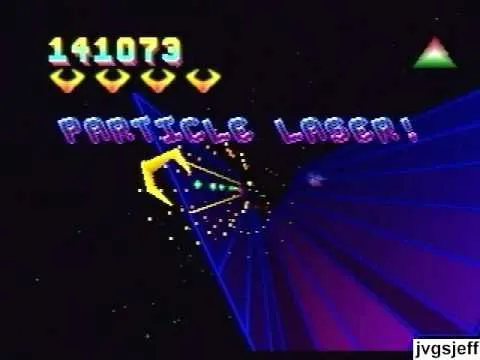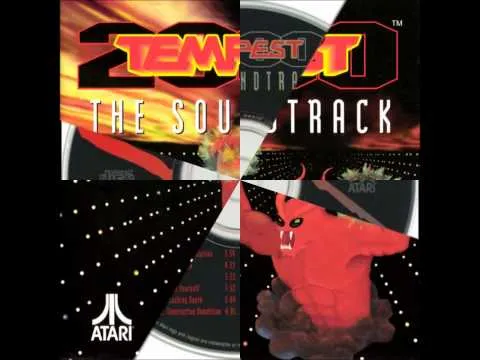
This post is avaliable in both English and Spanish. All screenshots captured by me.
If you want to read it in English, just scroll below. If you want to read it in Spanish, press CTRL+F and type "[SPA]" (without quotes) on the bar that shows up to get to the Spanish version immediately. Alternatively, just keep scrolling down until the end of the English section.
Este post está disponible en ambos Inglés y Español. Todas las capturas fueron tomadas por mi.
Si quieres leerlo en inglés, solo sigue abajo. Si quieres leerlo en español, presiona CTRL+F y escribe "-ESP-" (sin comillas) en la barra que aparece para llegar a la versión en Español inmediatamente. Alternativamente, solo sigue bajando hasta el final de la sección en Inglés.
English
Alright so...where does the "2000" come from?
Arcade classics from the 70s and 80s have often held up quite well in gameplay thanks to a simple premise and controls that start ramping up gradually to press the player into improving their skills. Pac-Man, Space Invaders, Asteroids, Centipede, Donkey Kong, Galaxian, Galaga...you name it! With the industry being relatively new at those years and the hardware limitations, the creativity on what was on your hands was spot-on.
As the videogame industry evolved, with more powerful hardware overall (arcades, consoles and computers), at one point there was a surge of refreshing these legendary arcade hits into something for a newer generation, taking advantage of better graphics, sound, and adding to the gameplay. While this trend can be seen with games from the past two decades like Pac-Man Championship Edition, Space Invaders Extreme and NES Remix (not arcade but still remixing old hits), it actually was present in the 90s as well!
For example, Namco Classic Collection Vol. 2 from 1996 had refreshed versions of Pac-Man, Galaga and Dig-Dug along with their original versions as an arcade cabinet. Donkey Kong (1994) for the Game Boy started with the first 4 levels form the original, but then transitions into an original game with a lot of new levels, music and enemies. And then there was Tempest 2000, an overhaul of the Atari classic Tempest with a big new spin and a curious track record of consoles.
A very unique trip with an addictive hook
Tempest 2000 was released first in 1994 for the Atari Jaguar, and ended up being the third best-selling game for the console during its lifespan (which might say something considering the console's failure, ignoring the lack of quality titles for it). With the original Tempest being a fairly simple yet unique game on visuals with vector graphics rendering "webs" where you had to move your ship and shoot down any enemies, Tempest 2000 amped everything up with detailed webs and enemies, colored dots on backgrounds, and extra flair over everything that happens. Extra points, 1-ups, messages when you get caught or grab a power-up, you name it.
The main addition to the game is the aforementioned power-ups, which are the Particle Laser, the Jump and the AI Droid. The Particle Laser is a stronger gun that gets rids of Spikes quickly, and the AI Droid spawns a helping cube that can shoot down enemies as well. My favorite however is the Jump, which might not sound special but allows you to jump off the top of the web, which makes dealing with enemies that are nearby or at the top much easier to do. Oh, and you always start with the Superzapper, which destroys everything on screen but only works once until you clear the stage or die.
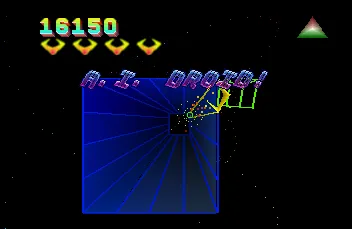
The enemies are mostly the same as the original: Flippers (red and a new faster blue variant) climb the web and try to catch you at the top, Spikers (green) leave spikes that kill you if you touch them when leaving a level, Fuseballs (multicolored) slowly fly at you, and Pulsars (yellow) can zap a lane and fry you if you happened to be there when they do. New to this game are Demon Heads (sort of self-explantatory; shoot their horns at you when you kill them so be ready to dodge), Mirrors (which appear way late at the game and can reflect your bullets), and UFOs which are very rare but can only be killed with the Jump powerup at hand.
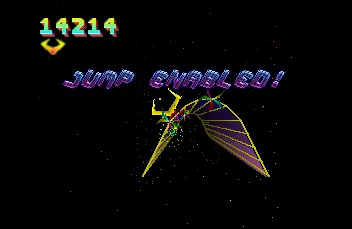
This is a very adrenaline-pumping game, with the added feeling of speed, the visuals and added enemies ramping up as you keep completing levels, and the techno rave soundtrack which just makes all the insanity go straight to your brain. The difficulty curve paired with the presentation and the Jump powerup (or the pressure of obtaining it as soon as you can when under trouble) is quite a trip, and made my arcade-loving self to adore this game.
The bonus stages are the weirdest part of the game, with trailing lights or a surreal flight in space as you try to keep on the green track or keep boosting through rings. Getting these down can be helpful on the long run as you can quickly stack some few 1-Ups if you can survive enough time.
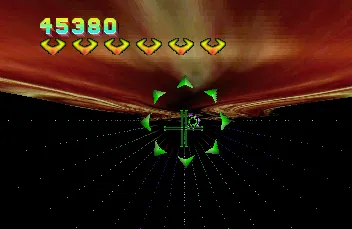
Oh, and the game doesn't only have a single mode. There's also the Traditional mode which is sort of a faithful remake of the original on the new engine without powerups and same levels, the Tempest Plus mode which adds some few extras from 2000 mode into the Traditional version but also lets you play with the AI Droid or even a second player, and Tempest Duel, which is a PVP mode where both players are on opposite sides of the web and have to get each other; both have mirrors to reflect bullets that get off when you fire.
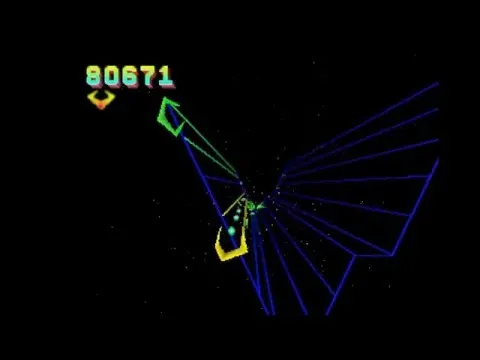
Footage of 2 players in Tempest Plus mode by myself as I didn't find footage anywhere else (video's from 2016 though so might have some different music added on top at times)
If you're interested in playing this game, you can emulate the original Jaguar version with this emulator (which I used for the screenshots), as it works perfectly and even runs the game smoother than in original hardware. Other options are the Saturn and PS1 ports of the game (though likely you would have to emulate either as well), getting a free clone called Typhoon 2001, or even getting Tempest 4000. However, those last three options (with the Saturn technically being closest to a straight port) have quite different visuals; specially T4K.
This little topic about T2K ports/clones will be something that I will cover soon enough in a follow-up post, but for now I would recommend playing the original Jaguar version through an emu for the best experience, or Typhoon 2001 for ease of setup. I hope that you enjoy this hidden gem! :)
Español -ESP-
Muy bien, entonces... ¿de dónde viene el "2000"?
Los clásicos de las máquinas recreativas de los años 70 y 80 a menudo se han mantenido bastante bien gracias a una premisa sencilla y a unos controles que empiezan a aumentar gradualmente para presionar al jugador a mejorar sus habilidades. Pac-Man, Space Invaders, Asteroids, Centipede, Donkey Kong, Galaxian, Galaga... ¡lo que sea! Siendo la industria relativamente nueva en aquellos años y con las limitaciones del hardware, la creatividad de lo que se tenía en las manos era total.
A medida que la industria del videojuego evolucionó, con un hardware más potente en general (arcades, consolas y ordenadores), en un momento dado hubo una oleada de refrescar estos legendarios éxitos de arcade en algo para una nueva generación, aprovechando mejores gráficos, sonido y añadiendo a la jugabilidad. Si bien esta tendencia puede verse en juegos de las dos últimas décadas, como Pac-Man Championship Edition, Space Invaders Extreme y NES Remix (que no es arcade, pero sigue remezclando viejos éxitos), en realidad también estuvo presente en los años 90.
Por ejemplo, Namco Classic Collection Vol. 2 de 1996 tenía versiones renovadas de Pac-Man, Galaga y Dig-Dug junto con sus versiones originales como arcade. Donkey Kong (1994) para la Game Boy empezaba con los 4 primeros niveles del original, pero luego pasaba a ser un juego original con un montón de niveles, música y enemigos nuevos. Y luego estaba Tempest 2000, una revisión del clásico de Atari, Tempest, con un nuevo y gran giro y un curioso historial de consolas.
Un viaje muy único con un gancho adictivo
Tempest 2000 fue lanzado por primera vez en 1994 para la Atari Jaguar, y acabó siendo el tercer juego más vendido para la consola durante su vida útil (lo que puede decir algo teniendo en cuenta el fracaso de la consola, ignorando la falta de títulos de calidad para ella). Mientras que el Tempest original era un juego bastante sencillo pero único en cuanto a su aspecto visual, con gráficos vectoriales que representaban "telarañas" en las que tenías que mover tu nave y derribar a los enemigos, el Tempest 2000 lo amplió todo con telarañas y enemigos detallados, puntos de colores en los fondos y un toque extra en todo lo que ocurría. Puntos extra, 1-ups, mensajes cuando te atrapan o coges un power-up, lo que sea.
La principal adición al juego son los mencionados potenciadores, que son el Láser de partículas, el Salto y el AO Droid. El Láser de Partículas es un arma más potente que se deshace de los Spikes rápidamente, y el AI Droid engendra un cubo de ayuda que también puede derribar a los enemigos. Sin embargo, mi favorita es la de Salto, que puede no sonar especial pero te permite saltar desde la parte superior de la telaraña, lo que hace que lidiar con los enemigos que están cerca o en la parte superior sea mucho más fácil de hacer. Ah, y siempre empiezas con el Superzapper, que destruye todo lo que hay en la pantalla pero sólo funciona una vez hasta que despejes el escenario o mueras.

Los enemigos son en su mayoría los mismos que en el original: Los Flippers (rojos y una nueva variante azul más rápida) trepan por la telaraña e intentan atraparte en la cima, los Spikers (verdes) dejan pinchos que te matan si los tocas al salir de un nivel, los Fuseballs (multicolores) vuelan lentamente hacia ti, y los Pulsars (amarillos) pueden hacer zapping en un carril y freírte si estás allí cuando lo hacen. Las novedades de este juego son las Demon Heads ( te disparan sus cuernos cuando las matas, así que prepárate para esquivarlas), los Espejos (que aparecen muy tarde en el juego y pueden reflejar tus balas) y los OVNIs, que son muy raros pero sólo pueden matarse con el potenciador de salto a mano.

Este es un juego da mucha adrenalina, con la sensación de velocidad añadida, los efectos visuales y los enemigos añadidos que aumentan a medida que vas completando niveles, y la banda sonora tecno rave que hace que toda la locura vaya directamente a tu cerebro. La curva de dificultad combinada con la presentación y el potenciador de salto (o la presión de obtenerlo tan pronto como puedas cuando estés en apuros) es todo un viaje, e hizo que mi yo amante de los arcades adorara este juego.
Las fases de bonificación son la parte más extraña del juego, con luces de arrastre o un vuelo surrealista en el espacio mientras intentas mantenerte en la pista verde o seguir impulsándote a través de los anillos. Conseguirlas puede ser útil a largo plazo, ya que puedes acumular rápidamente algunos 1-Ups si consigues sobrevivir el tiempo suficiente.

Ah, y el juego no sólo tiene un único modo. También está el modo Tradicional, que es una especie de remake fiel del original en el nuevo motor, sin potenciadores y con los mismos niveles, el modo Tempest Plus, que añade algunos extras del modo 2000 a la versión Tradicional, pero que también te permite jugar con el droide de la IA o incluso con un segundo jugador, y Tempest Duel, que es un modo PVP en el que los dos jugadores están en lados opuestos de la red y tienen que acabar el uno con el otro; ambos tienen espejos para reflejar las balas que se desprenden cuando disparas.

Video de 2 jugadores en el modo Tempest Plus por mí mismo, ya que no encontré otro video subido (el vídeo es de 2016, por lo que puede tener una música diferente añadida en algunos momentos).
Si estás interesado en jugar a este juego, puedes emular la versión original de Jaguar con este emulador (que he utilizado para las capturas de pantalla), ya que funciona perfectamente e incluso ejecuta el juego con más fluidez que en el hardware original. Otras opciones son los ports de Saturn y PS1 del juego (aunque probablemente también tendrías que emular alguno de ellos), conseguir un clon gratuito llamado Typhoon 2001, o incluso conseguir el Tempest 4000. Sin embargo, estas tres últimas opciones (siendo la de Saturn la que más se aproxima a un port directo) tienen efectos visuales bastante diferentes; especialmente T4K.
Este pequeño tema sobre los ports/clones de T2K será algo que trataré pronto en un post posterior, pero por ahora recomendaría jugar a la versión original de Jaguar a través de una emu para obtener la mejor experiencia, o a Typhoon 2001 para facilitar la configuración. Espero que disfruten de esta joya oculta. :)
